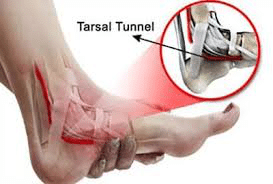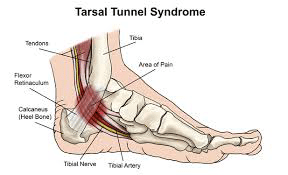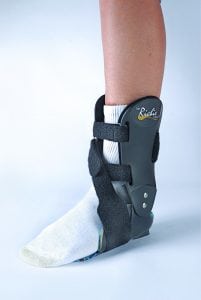Tarsal Tunnel Syndrome
Tarsal tunnel syndrome is a compression, or squeezing, on the posterior tibial nerve that produces symptoms anywhere along the path of the nerve running from the inside of the ankle into the foot.
Tarsal tunnel syndrome is similar to carpal tunnel syndrome, which occurs in the wrist. Both disorders arise from the compression of a nerve.
Tarsal tunnel syndrome usually develops as a result of a previous ankle injury. Symptoms can include burning pain at the sole of the foot that’s worse when standing or during activity. Other symptoms include numbness or tingling at the base of the foot.
Treatment includes avoiding certain activities. It may also include orthotics and anti-inflammatory medication. In rare cases, steroid injections can reduce inflammation.
Patients with Tarsal Tunnel Syndrome typically complain of numbness in the foot radiating to the big toe and the first 3 toes, pain, burning, electrical sensations, and tingling over the base of the foot and the heel. Depending on the area of entrapment, other areas can be affected. Ankle pain is also present in patients who have high level entrapments. Inflammation or swelling can occur within this tunnel for a number of reasons. The flexor retinaculum has a limited ability to stretch, so increased pressure will eventually cause compression on the nerve within the tunnel. As pressure increases on the nerves, the blood flow decreases. Nerves respond with altered sensations like tingling and numbness. Fluid collects in the foot when standing and walking and this makes the condition worse. As small muscles lose their nerve supply they can create a cramping feeling.
Causes of Tarsal Tunnel Syndrome
Tarsal tunnel syndrome is caused by anything that produces compression on the posterior tibial nerve, such as:
- A person with flat feet is at risk for developing tarsal tunnel syndrome, because the outward tilting of the heel that occurs with fallen arches can produce strain and compression on the nerve.
- An enlarged or abnormal structure that occupies space within the tunnel can compress the nerve. Some examples include a varicose vein, ganglion cyst, swollen tendon or arthritic bone spur.
- An injury, such as an ankle sprain, may produce inflammation and swelling in or near the tunnel, resulting in compression of the nerve.
- Systemic diseases, such as diabetes or arthritis, can cause swelling, thus compressing the nerve.

Symptoms of Tarsal Tunnel Syndrome
Patients with tarsal tunnel syndrome experience one or more of the following symptoms:
- Tingling, burning or a sensation similar to an electrical shock
- Numbness
- Pain, including shooting pain
Diagnosis is based upon physical examination findings. Patients’ pain history and a positive Tinel’s Sign (a tingling electric shock sensation that occurs when you tap over an affected nerve; the sensation usually travels into the foot but can also travel up the inner leg as well) are the first steps in evaluating the possibility of tarsal tunnel syndrome. X-ray can rule out fracture. MRI can assess for space occupying lesions or other causes of nerve compression. Ultrasound can assess for synovitis or ganglia. Nerve conduction studies alone are not, but they may be used to confirm the suspected clinical diagnosis.

Conservative Treatment
Many treatment options, are available and used in combination to treat tarsal tunnel syndrome. They include:
- Rest
- Ice
- Oral Nonsteroidal anti-inflammatory drugs (NSAIDs), such as ibuprofen, help reduce the pain and inflammation.
- Immobilization. Restricting movement of the foot by wearing a cast or CAM Walker (‘Moonboot’) can enable the nerve and surrounding tissue to heal.
- Physical therapy. Ultrasound therapy, exercises, strapping and other physical therapy modalities may be prescribed to reduce symptoms.
- Injection therapy. Injections of a local anaesthetic provide pain relief, and an injected corticosteroid may be useful in treating the inflammation.
- Orthotic devices. Custom shoe inserts may be prescribed to help maintain the arch and limit excessive motion that can cause compression of the nerve.
- Shoes. Supportive shoes may be recommended.
- Bracing. Patients with flatfoot or those with severe symptoms and nerve damage may be fitted with a special ankle (‘tri-lock’) brace or Richie brace to reduce the amount of pressure on the foot.
The Richie Brace® is a revolutionary alternative to traditional ankle braces and ankle-foot orthoses (AFO’s). The lightweight construction and low profile design features of the Richie Brace allows better shoe fit, more freedom of movement and reduced pain from injury. TFAAC Podiatrists are highly trained and specialise in prescribing these revolutionary customs made braces. The Richie Brace has become a gold standard treatment in the orthotics industry. It is universally recognized by Podiatrists, Pedorthists, Orthotists and Orthopedic surgeons as a unique, breakthrough technology to treat a wide variety of foot and ankle pathologies such as foot drop, ankle arthritis, ankle sprains and many other ankle injuries.

Surgical Treatment
If non-invasive treatment measures fail, tarsal tunnel release surgery may be recommended to decompress the area.
At the Foot and Ankle Clinic our highly qualified team of Podiatrists are all members of the Australian Podiatry Association and offer a combined 50 years’ experience. They are trained to diagnose and effectively treat Tarsal Tunnel Syndrome via a range of proven treatments.
Put your feet in our hands! See us today in Chadstone, Moe, Sale, Traralgon, Warragul & Online Store and Retail Enquiries. NO REFERRAL NEEDED!.


